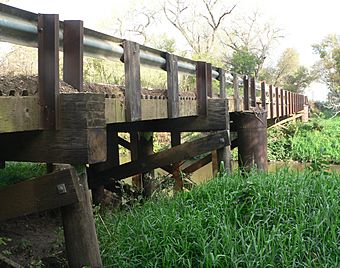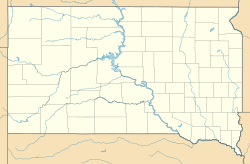South Dakota Department of Transportation Bridge No. 63-210-282 facts for kids
Quick facts for kids |
|
|
South Dakota Department of Transportation Bridge No. 63-210-282
|
|
 |
|
| Nearest city | Centerville, South Dakota |
|---|---|
| Area | less than one acre |
| Built | 1909 |
| Built by | Iowa Bridge Co. |
| Architectural style | Pratt through truss |
| MPS | Historic Bridges in South Dakota MPS |
| NRHP reference No. | 99001216 |
| Added to NRHP | September 29, 1999 |
The South Dakota Department of Transportation Bridge No. 63-210-282 was a historic bridge located in the countryside of Turner County, South Dakota. It used to carry 461st Avenue over the East Fork Vermillion River. This bridge was built in 1909. It was a great example of bridges made by the Iowa Bridge Company for the county. Because of its history, it was added to the National Register of Historic Places in 1999. The main part of the bridge was later replaced in 2009-2010.
What Was This Bridge Like?
The South Dakota Department of Transportation Bridge No. 63-210-282 was found about 1 mile (1.6 km) west and 1.1 miles (1.8 km) south of Centerville. It helped people cross the East Fork Vermillion River. This bridge had three parts. It had a main section in the middle and two shorter sections on each side.
The main part was a special type called a Pratt through truss. This means the bridge's framework was above the road, forming a kind of tunnel. This main section was about 95 feet (29 meters) long. It rested on strong steel poles. The parts on the very ends of the bridge were made of timber. The metal pieces of the bridge were joined together with rivets. The road part of the bridge was made of two layers of wood planks. These planks were supported by timber beams and steel I-beams.
Who Built This Bridge and Why Was It Special?
The Iowa Bridge Company, from Des Moines, Iowa, built this bridge in 1909. This company had a special agreement with the county. They built many steel truss bridges for the county between 1905 and 1911. This bridge was a typical example of the work they did.
It was important because it showed how bridges were built back then. It was a well-kept example of its kind. That's why it was listed on the National Register of Historic Places. This list includes important places in American history. Even though the main part of the bridge was replaced later, it remains a part of the area's history.


